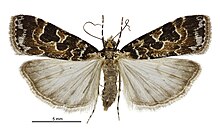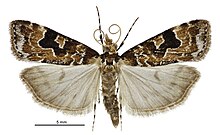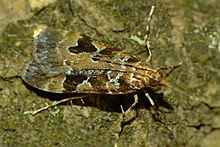| Scoparia ustimacula | |
|---|---|

| |
| Female | |

| |
| Male | |
| Scientific classification | |
| Domain: | Eukaryota |
| Kingdom: | Animalia |
| Phylum: | Arthropoda |
| Class: | Insecta |
| Order: | Lepidoptera |
| Family: | Crambidae |
| Genus: | Scoparia |
| Species: | S. ustimacula |
| Binomial name | |
| Scoparia ustimacula C. Felder, R. Felder & Rogenhofer, 1875 | |
| Synonyms | |
| |
Scoparia ustimacula, also known as the black-marked brown Scoparia moth, is a species of moth in the family Crambidae. It was described by Cajetan Felder, Rudolf Felder and Alois Friedrich Rogenhofer in 1875. It is endemic to New Zealand and can be found in the North, South and Stewart Islands. This species inhabits dense native forest at altitudes from sea level to approximately 1000 m. Although little is known of the life history of this species, larvae have been observed feeding on Hydrocotyle species. Adults are on the wing year round but are more commonly observed from September to March. Adults are nocturnal, are attracted to light and have been collected by beating scrub.
Taxonomy
This species was first described by Cajetan Felder, Rudolf Felder and Alois Friedrich Rogenhofer in 1875 using specimens collected in Nelson by T. R. Oxley. Arthur Gardiner Butler, thinking he was describing a new species, named it Scoparia conifera in 1879. Edward Meyrick synonymised this name in 1884 and detailed the reasons for this decision in 1885. George Hudson described and illustrated the species in his 1928 book The butterflies and moths of New Zealand. The male holotype is held at the Natural History Museum, London.
Description


Hudson described this species as follows:
The expansion of the wings is a little over 3⁄4 inch. The fore-wings are bright golden-brown and very glossy with dark brown markings edged with white; there is a small brown patch at the base; the first line is very slender, white, faintly edged with brown towards the termen; the orbicular and claviform are very large, touching, dark brown edged with white; the reniform is extremely large and conspicuous, very dark brown edged with white; the second line is white and very slender; the sub-terminal line is broad, white, broken near the middle and rather irregular; there is a terminal series of blackish marks. The hind-wings are pale och eous, glossy, with a grey discal spot and terminal shading.
This moth is distinctive in appearance and tends to be larger when collected at higher altitudes. S. ustimacula can be distinguished by the pair of large, dark brown, white boarded, forewing markings. Sometimes these patches join to form an M shape. The male of this species has long antennal ciliations.
Distribution
This species is endemic to New Zealand and is found throughout the country. It is regarded as being fairly common.
Habitat
S. ustimacula inhabits dense native forested areas and can be collected by beating the scrub and overhanging forest branches. This species can be found at altitudes from sea level up to approximately 1000 m.
Behaviour
The adults of this species are on the wing throughout the year but are more frequently seen from September to March. The adults active at night and are attracted to light.
Host species

Although little is known of the life history of this moth, the larvae of S. ustimacula feed on Hydrocotyle species.
References
- "GlobIZ search". Global Information System on Pyraloidea. Retrieved October 17, 2017.
- ^ Dugdale, J. S. (1988). "Lepidoptera - annotated catalogue, and keys to family-group taxa" (PDF). Fauna of New Zealand. 14: 160. Retrieved 28 January 2018.
- Gordon, Dennis P., ed. (2010). New Zealand inventory of biodiversity: Kingdom animalia: chaetognatha, ecdysozoa, ichnofossils. Vol. 2. p. 458. ISBN 978-1-877257-93-3. OCLC 973607714. OL 25288394M. Wikidata Q45922947.
- Felder, Cajetan; Rogenhofer, Alois Friedrich (1864–1867). "Reise der österreichischen Fregatte Novara". Reise der österreichischen Fregatte Novara um die Erde in den Jahren 1857, 1858, 1859 unter den Befehlen des Commodore B. Von W. pt.9:Bd.2:Abt.2 (1864-1867) Atlas: Plate CXXXV fig 17 – via Biodiversity Heritage Library.
- Arthur Gardiner Butler (1879). "On a small collection of Heterocerous Lepidoptera, from New Zealand". Cistula entomologica. 2: 487–511. Wikidata Q104215588.
- Edward Meyrick (1884). "Descriptions of New Zealand Microlepidoptera. IV. Scopariadae". New Zealand Journal of Science. 2: 236. Wikidata Q113372586.
- ^ Edward Meyrick (1885). "Art. XI. — Descriptions of New Zealand Micro-Lepidoptera". Transactions and Proceedings of the New Zealand Institute. 17: 91. ISSN 1176-6158. Wikidata Q113379604.
- ^ Hudson, G. V. (1928), The butterflies and moths of New Zealand, Illustrator: George Hudson, Wellington: Ferguson and Osborn Limited, p. 189, LCCN 88133764, OCLC 25449322, Wikidata Q58593286
- ^ Hoare, Robert J. B. (2014). A photographic guide to moths & butterflies of New Zealand. Olivier Ball. Auckland. p. 83. ISBN 978-1-86966-399-5. OCLC 891672034.
{{cite book}}: CS1 maint: location missing publisher (link) - "NZOR Name Details - Scoparia ustimacula Felder & Rogenhofer, 1875". www.nzor.org.nz. Landcare Research New Zealand Ltd. Retrieved 28 January 2018.
- ^ David Edward Gaskin (1966), The butterflies and common moths of New Zealand, p. 169, Wikidata Q115000559
- "Scoparia ustimacula - Invertebrate herbivore report". plant-synz.landcareresearch.co.nz. Retrieved 2019-07-22.
| Taxon identifiers | |
|---|---|
| Scoparia ustimacula | |